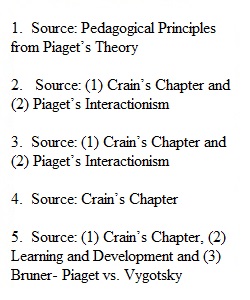


Q 1) According to Piaget, learning is an active process. This means that teaching can only take place indirectly. Explain how teaching should be organized according to Piagetian constructivist theory. Discuss the implications for education of 3 Piagetian theoretical principles. Be specific about how these principles render constructivist instruction different from traditional instruction (i.e., transmission model) 2) Piaget’s theory views children as active in constructing their development. Explain ‘what” children construct (mentally, psychologically) as they develop intellectually (i.e., cognitively) and give an example. 3) According to Piaget, children adapt to the world through a dynamic balance between two complementary processes. What are they? Give one example of each of these processes to illustrate how they drive the construction of knowledge in children. How is that related to intelligence? 4) Why is reversibility an important characteristic of children’s reasoning at the stage of concrete operations? Provide an example that demonstrates how children’s reasoning changes from preoperational to concrete operational as the child’s thought achieves reversibility. 5) How does Piaget explain the child’s movement from one stage to the next? In other words, what is the main force, according to him, that drives cognitive development? Why is this explanation considered the weakest part of Piaget’s theory?
View Related Questions